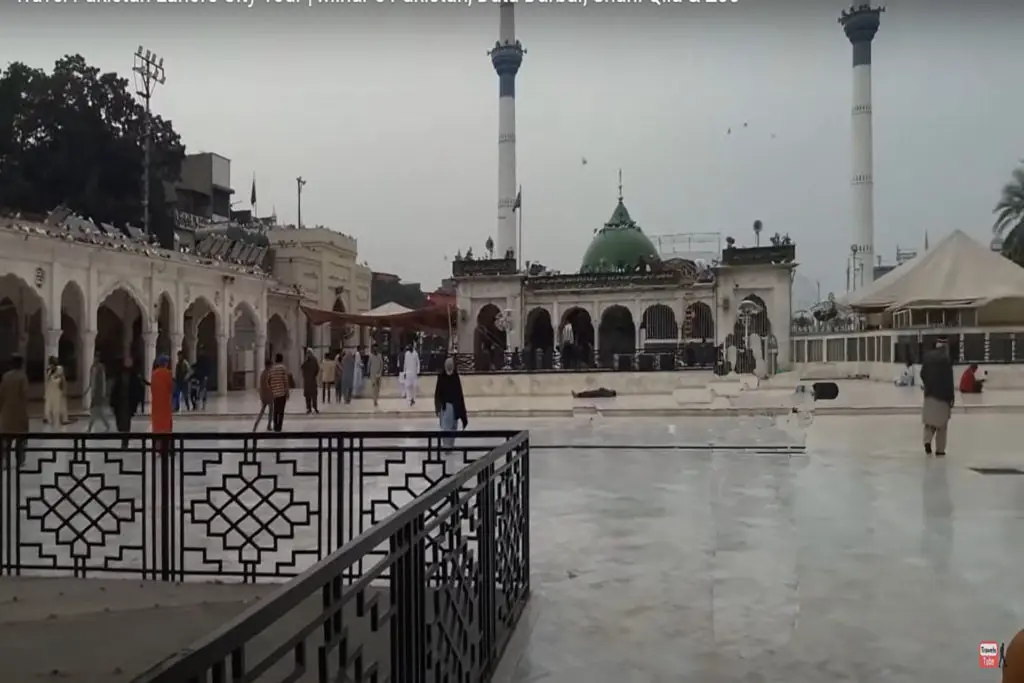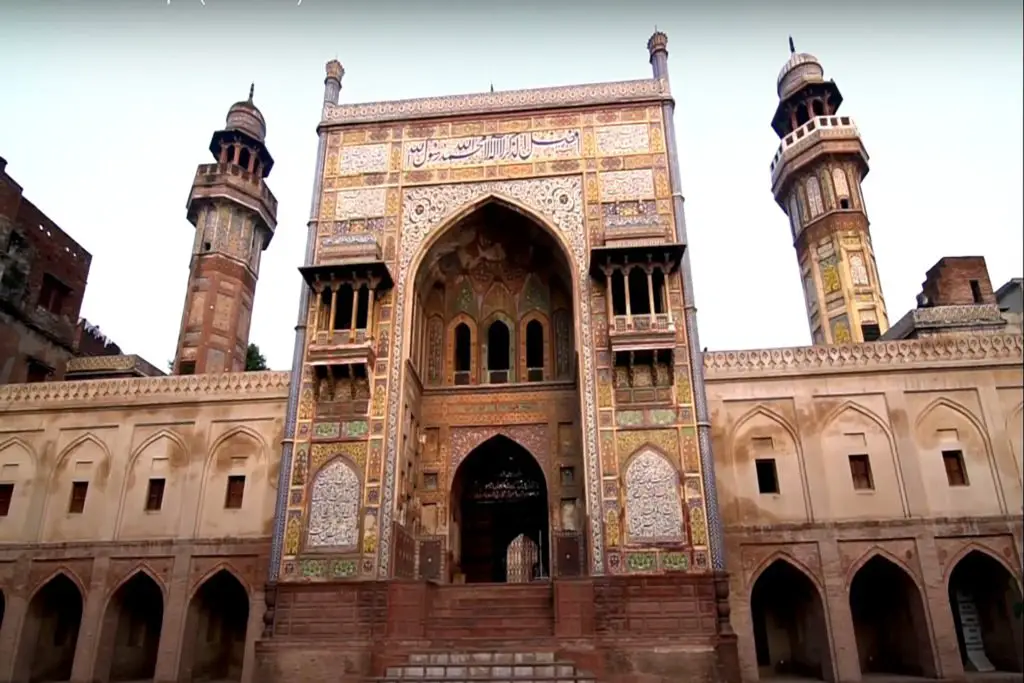Data Darbar (also spelled Data Durbar in the city of Lahore (Punjab, Pakistan), is the largest Sufi shrine in South Asia. Data Darbar Ganj Baksh Lahore was built to house the remains of Ali Hujwiri, commonly known as Data Ganj Baksh, a Sufi saint from Ghazni in present-day Afghanistan, who is said to have lived on the site in the 11th century AD.
Data Darbar of Ali Hujweri site is considered the holiest place in Lahore and attracts up to a million visitors for its annual Urs festival.
Location of Data Darbar Lahore
Data Darbar is located in the center of the old city of Lahore. Nearby are Lower Mall Road, Bhati Gate, Gawalmandi, and Karbala Gamay Shah.
History of Data Darbar Ganj Baksh Lahore
The shrine was originally established as a simple tomb next to a mosque Ali Hujwiri had built on the outskirts of Lahore in the 11th century.
In the 13th century, the belief that the spiritual powers of great Sufi saints were attached to their burial sites was widespread in the Muslim world, so a larger shrine was built to commemorate the Hujwiri burial ground during the Mughal period. The shrine complex was expanded in the 19th century and the Hujwiri Mosque was rebuilt.
Shrine Data Ganj Baksh Management
The shrine came under the control of the Pakistani government as part of the Auquf Ordinance of 1960, with the official aim of preventing shrine administrators across the country from financially exploiting devotees.
The shrine was greatly expanded in the 1980s, during which time the shrine became the largest in South Asia. Offices for NGOs, a library, a madrasa, a police station, a parking lot, and offices were added under his regime.
During that time, dedicated spaces for musical performances and a new free kitchen have also been added. Since its massive expansion, new markets have sprung up around the site.
From 1965, the mehfil-e-sama, a two-day qawwali music festival, was held next to the shrine, which moved to a nearby school in 1992.
The Hujwiri shrine is housed in a Mughal-era tomb crafted from carved white marble. The tomb is surrounded by a massive marble courtyard, while the new educational institution in the shrine complex uses modernist architecture.
Importance of Data Ganj Bakshm in Suffism
The place is considered to be the holiest place in Lahore. The shrine has become a major economic, political, and social center in Lahore and is one of the few places in Lahore where the extremely rich and the extremely poor share space.
It is widely believed among devotees that the saint buried in the shrine is the supreme authority over all Sufi saints in the Indian subcontinent and that no new Sufi saint can immigrate to the subcontinent without obtaining permission from the Hujwiri spirit.
After the establishment of a shrine dedicated to Hujwiri, Muslims and non-Muslims alike visited his grave seeking his blessings. Famous personalities like Baba Farid, Moinuddin Chishti, Nizamuddin Auliya, Dara Shikoh, and Allama Iqbal all paid obeisance to the shrine and pledged allegiance to Hujwiri. Former Prime Minister Nawaz Sharif was a frequent visitor to the shrine.
Hujwiri’s teachings were critical of practices associated with South Asian Islam, such as drug use and dancing. He also taught that Sufi saints were themselves still bound by the demands of Islam, and so is revered by reformist Muslims who are critical of Sufi practice as well as traditionalist Muslims who revere Sufi shrines.
Qawwali performances are held regularly at the shrine. On special occasions, the shrine is decorated with lights, dinner is prepared for thousands of visitors who also participate in dancing while musicians play Sufi music for hours. At the border of the shrine, Muslim worshipers recite the Quran and pay homage to the Prophet Muhammad (PBUH).
Social Services at Data Darbar Lahore
The sanctuary provides a wide range of social services that have made it a popular center for poor residents. In a custom that is 1,000 years old, the shrine offers free food to up to 50,000 visitors a day.
Patrons facing personal hardships often donate money or labor to the shrine’s free kitchen fund, in keeping with Islam’s emphasis on feeding the poor. The sanctuary also provides education for students in nearby schools and helps fund local hospitals as part of its social mission.
Access to Data Darbar Lahore
The shrine remains open at all times and welcomes visitors who freely enter the premises. Approximately 30,000 to 60,000 visitors visit the shrine daily, although this number can double on religious holidays and Thursdays, the traditional shrine night. About 1,000,000 devotees visit the shrine during the annual urs festival.
The shrine is served by the Bhatti Chowk metro station on the Lahore Metrobus.
Management of Shrine
The shrine is managed as part of the Auqaf Foundation under the Auqaf Ordinance 1960. The shrine is managed by approximately 200 full-time staff, excluding security services.
The shrine produces the most revenue for the Auqaf Board of the approximately 400 shrines under its control in the Punjab province and contributes around 33% of the board’s revenue. The shrine collects 4 times more revenue than is spent on the upkeep of the shrine.
Considered central to all shrines in Punjab, religious practices and preaching are subject to greater government regulation than at other shrines in Pakistan.
Who was Data Darbar?
Data Darbar, located in Lahore, Punjab, is the largest Sufi mausoleum in South Asia. It was built to house all the remains of al-Hujwīrī, commonly recognized as ‘Data Ganj Baksh’, a Sufi saint belonging to Ghazni.
Urs dates of Ganj Bakhsh Al-Hujwiri
Known as the Data Darbar, the Hujwiri burial ground has become an important pilgrimage site for Sufi devotees and is one of the most visited shrines in South Asia.
Who built Data Darbar?
It was originally built by the Ghaznavi king Sultan Zakiruddin Ibrahim later in the 11th century and has been expanded several times since then.
Who is Data Hajveri?
He became a well-known Sufi saint in the region, and in his last years, Ali Hujwiri compiled the Kashf al-Mahjub.
When Ali Hajveri was Born?
Data Ganj Baksh, Ali Hajveri was born in 990 AD.
He was born in Ghazni, Afghanistan in 990 AD, where he grew up to be one of the greatest Persian Muslim mystics and theologians.







